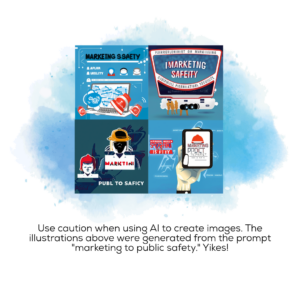
For the sake of argument, we’re going to assume you have a marketing communication plan to reach your customers in public safety. Even if it’s a bit dusty and you haven’t looked at it in a while, you should still have one.
That said, chances are good that when the pandemic hit you had to pivot and at least a few things you’d planned on doing quickly got shelved. But even if COVID-19 led you to create a whole new approach to your strategic communications and marketing, it’s critical to revisit your communication plan periodically to see what’s working and still relevant to your business goals, and what’s not. (The advice that follows largely holds true whether you’re updating your comm plan or creating one from scratch. If you’re new to the process, check out the section we’ve included at the end.)
Given that we’re nearly on the cusp of a brand-new year (how did that happen?), this is an ideal time to take your communication plan off the proverbial shelf. As you give it a second look, start by asking yourself and your marketing team a few key questions:
Have our mission and vision as an organization changed?
Maybe not, but the pandemic has led many leaders in all industries, including public safety, to reevaluate what truly matters. These days, people aren’t talking so much about “the new normal,” but rather “the next normal.” Maybe staffing challenges have led to a much greater emphasis on hiring and retaining qualified employees. That could translate into a shift in marketing dollars toward recruitment or to adopting new technology that makes the job easier and safer for officers, firefighters or EMTs/paramedics, for example.
Or maybe more of your workforce is remote than ever before, and communication skills have taken on a much bigger focus in how you hire. Or, like so many of our clients, you might have gone from primarily doing business in person at conferences and other events and now need a different approach to connect with customers and prospects. In that case, your tactics will naturally look different when it comes to making and nurturing those connections.
If your mission and vision as a company or agency remain the same, you might want your communication plan to include outreach that reminds employees and customers—and educates prospects—about what you stand for and how you stand out from the pack. (That’s almost always a message that bears repeating.) And it’s probably clear already that if the products/services you’re offering your public safety customers have shifted, so too should your approach to marketing what you offer. We regularly work with companies that want to expand into related markets and want guidance on how to do so strategically.
Is our communication plan truly strategic?
Too often communication teams focus their marketing energy on executing tactics—eblasts, videos, paid media, blogs, case studies, white papers, events, webinars, social campaigns, and the like—without first identifying how those activities map back to a larger strategy.
Sure, tactics are shiny. They show action. And many are measurable. But if you don’t know how they roll up into a plan that aims to help you accomplish big-picture goals, you may be wasting time and other very valuable resources. Make sure your messages consistently track back to why your organization exists, what it does and the difference you make. Simple as that.
Do we know what people are saying about us now?
One of the key elements of any communication plan we create for our clients is a benchmarking exercise. Which means we talk to their customers, employees, prospects and industry opinion leaders to find out how their organization is really seen.
We ask, among other things:
- What are they known for?
- What are their strengths?
- Where can they do better?
- And perhaps most important: Do these opinions align with what the company wants to be known for and how they see themselves?
With this baseline, over time it’s possible to measure how opinions change—and especially if they’re shifting in the direction of your marketing goals.
Whether you have an agency conduct benchmarking or you do it yourself, it’s a valuable evaluation to do at least periodically. If the strategy and tactics that make up your communication plan are working hard for you, progress toward your goals should be evident. But you probably won’t know unless you ask these questions—and get truly forthright answers.
It’s worth mentioning that understanding what people say about you applies as much to your own employees as it does to external stakeholders like customers and competitors. Many organizations struggle with what we call “messaging discipline.” Their products/services and values are described in too many different ways; the sales department says one thing, while customer service says another and HR puts out another message altogether.
Competing narratives undermine your messaging, of course. The core of all communication should be consistent and always reinforce an organization’s positioning and key messages. This is where the communication plan is a real asset: It specifies what you should say and how you should say it. When there’s a commitment by the team to use these messages, clarity is much easier to achieve. Not only that, but your collective message can be amplified far more effectively.
If you’re not sure how to apply this in your own marketing team, try developing an elevator pitch the entire sales and marketing teams use. It’s also useful to conduct periodic SWOT (strengths, weaknesses, opportunities, threats) analyses that take into account what’s changed in your market and in the world at large.
Another exercise: Talk through the language you use to describe your organization in press releases, on your website and in conference hand-outs. Is everything aligned and connected back to that core positioning and key messages? If not, how can you improve what you’re “saying”? This isn’t about being rigid, by the way; there will always be slight differences. Your signage at, say, an EMS conference will definitely be different from a flyer directed at firefighters or 911 telecommunicators. “Know your audience” is still the first and last rule of good communication of any kind.
You don’t need us to tell you that every communication touchpoint is an opportunity—whether it’s a prospect’s first impression or re-engaging a former customer. Make that opportunity count by reinforcing clear, consistent messaging.
In most cases, when you update your communication plan you won’t be rewriting the whole plan. And if nothing else, you can kick off the process by posing a few simple questions to your team at your next marketing meeting:
- Are we living our comm plan, day in and day out? If not, why not?
- Does it still meet our needs—does it feel true and accurate? Or a little dated?
- Do we need to review and update it more often? If so, what’s the best way to ensure that actually happens?
- Are there any obvious things we can refresh right now?
If You Don’t Have a Strategic Communication Plan
So why do you need a comm plan in the first place? Among other benefits, a hard-working, effective plan:
- ensures that any tactics you execute support your broader strategy (meaning whatever you decide to do is worthy of your budget and time)
- acts as a road map for where to focus marketing energy in order to get the most ROI
- identifies the right messaging and makes it easier to get everyone to actually use that messaging
Here are a few critical elements of any plan:
- Positioning statement: This communicates what your organization stands for and why someone should engage with it. (Be careful trying to squeeze too much into this one statement.)
- Target audiences: Who are the most important individuals and organizations with whom you communicate?
- Key messages: What you want your audiences to know about you
- Communication strategies: The 30,000-foot view of the most effective ways to accomplish your outreach goals and long-term recommendations
- Marketing tactics: How you put strategy into action, prioritizing the most important activities to implement
- Metrics: What will you measure to determine what is (and isn’t) working?
If you’d like help creating or updating your organization’s communication plan or determining the right strategy to reach law enforcement, 911, the fire service, EMS or related public sector industries,we’d love to start a conversation.






 The RedFlash Group is a GSA Contract Holder under Schedule 541, Advertising and Integrated Marketing Solutions
The RedFlash Group is a GSA Contract Holder under Schedule 541, Advertising and Integrated Marketing Solutions